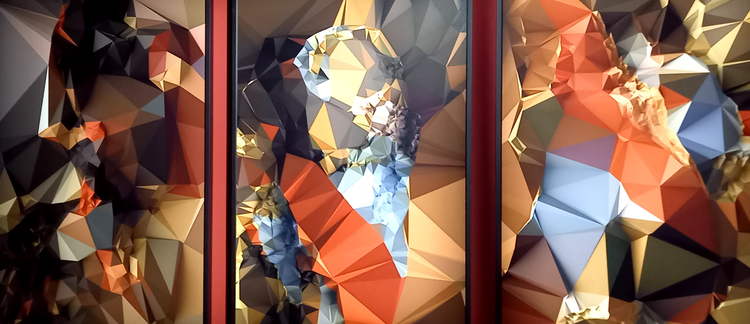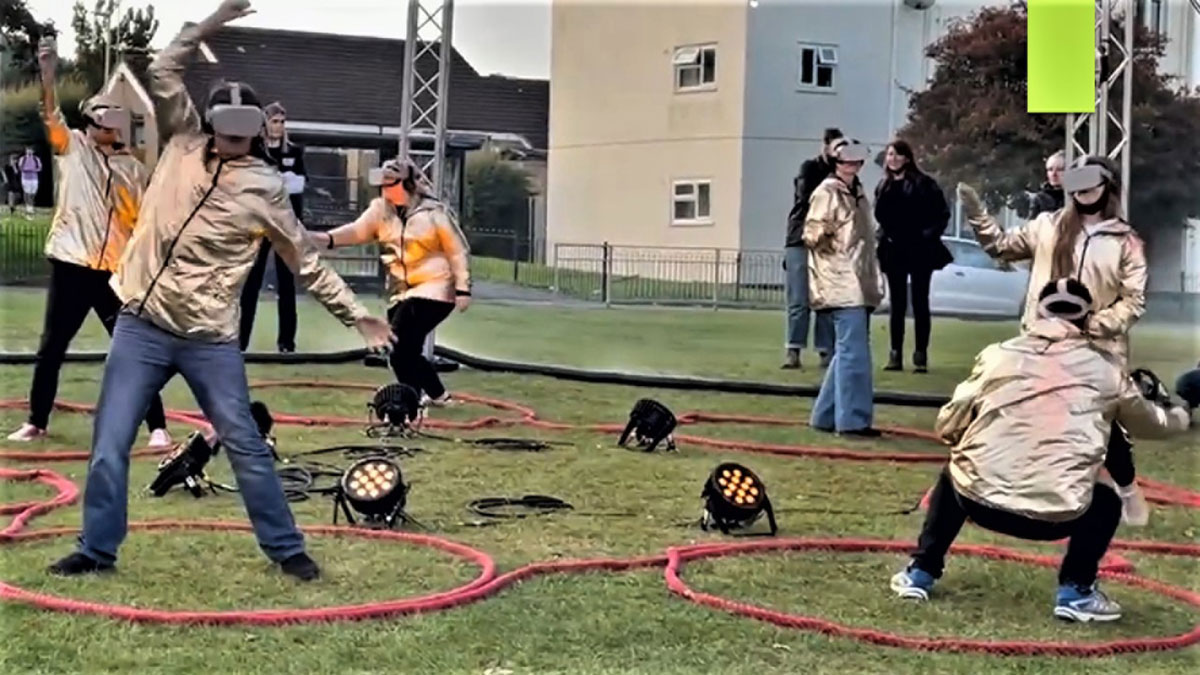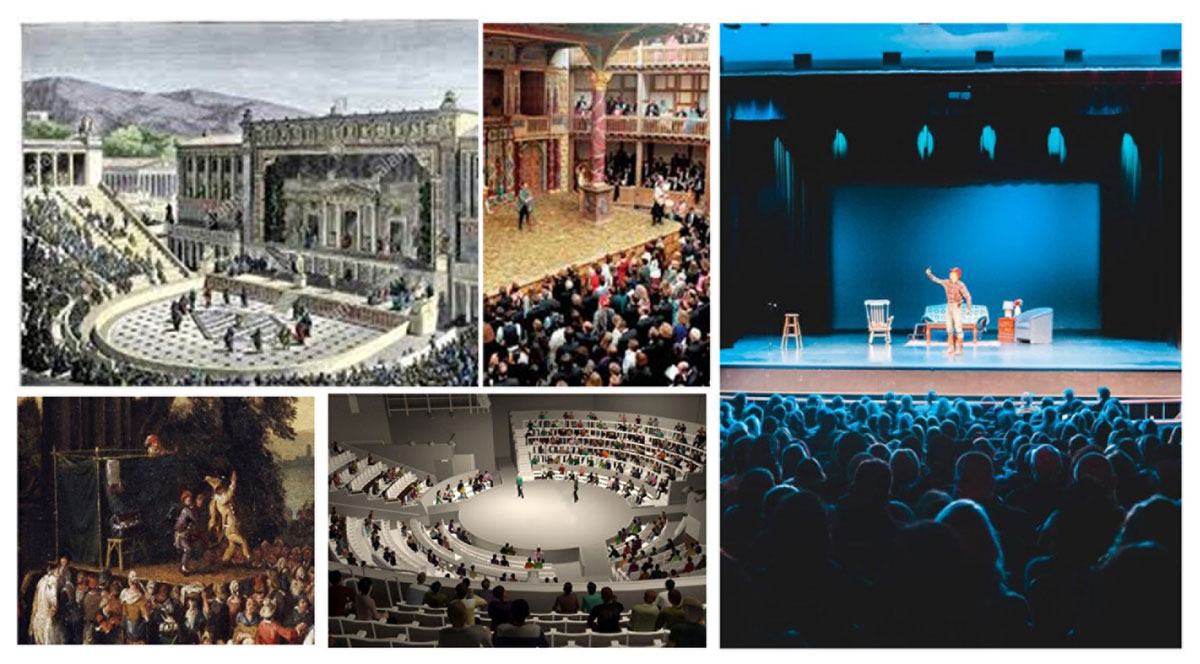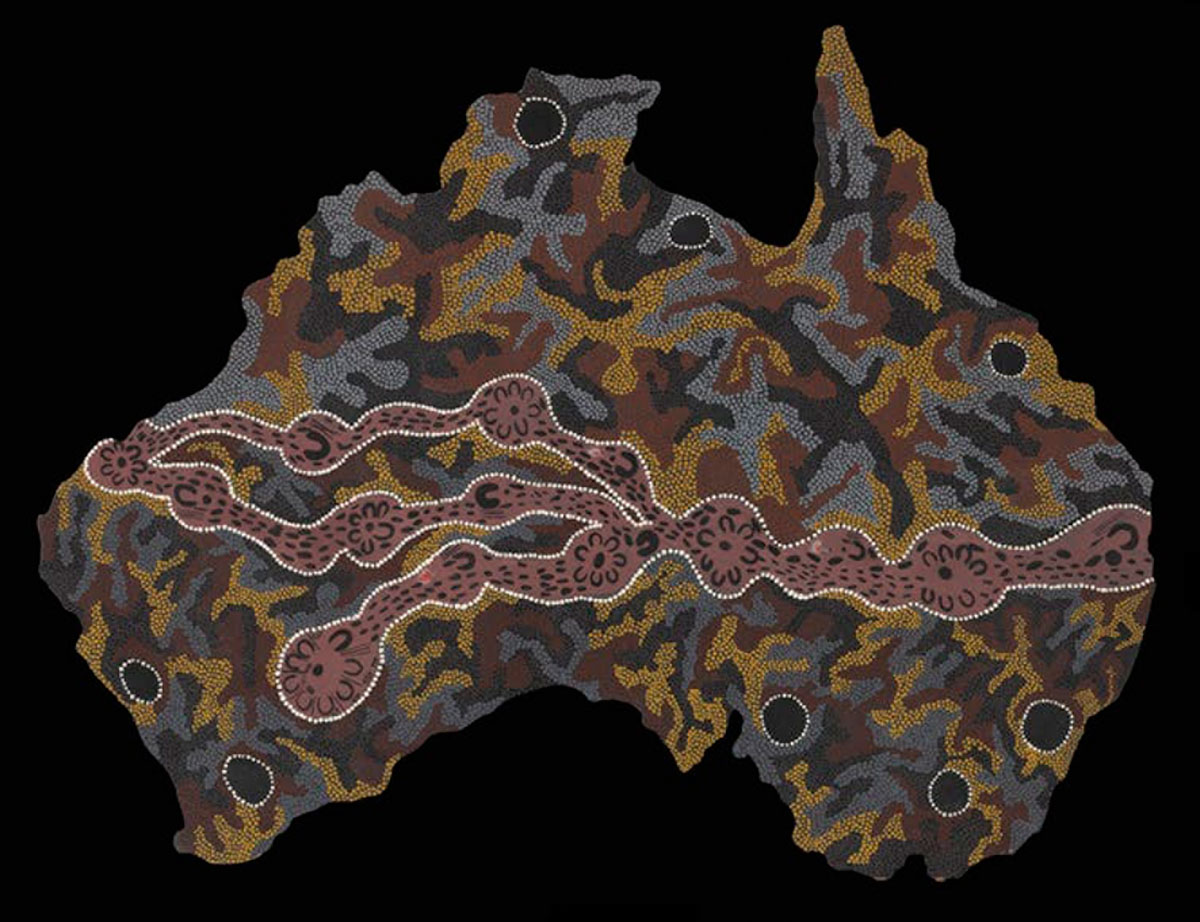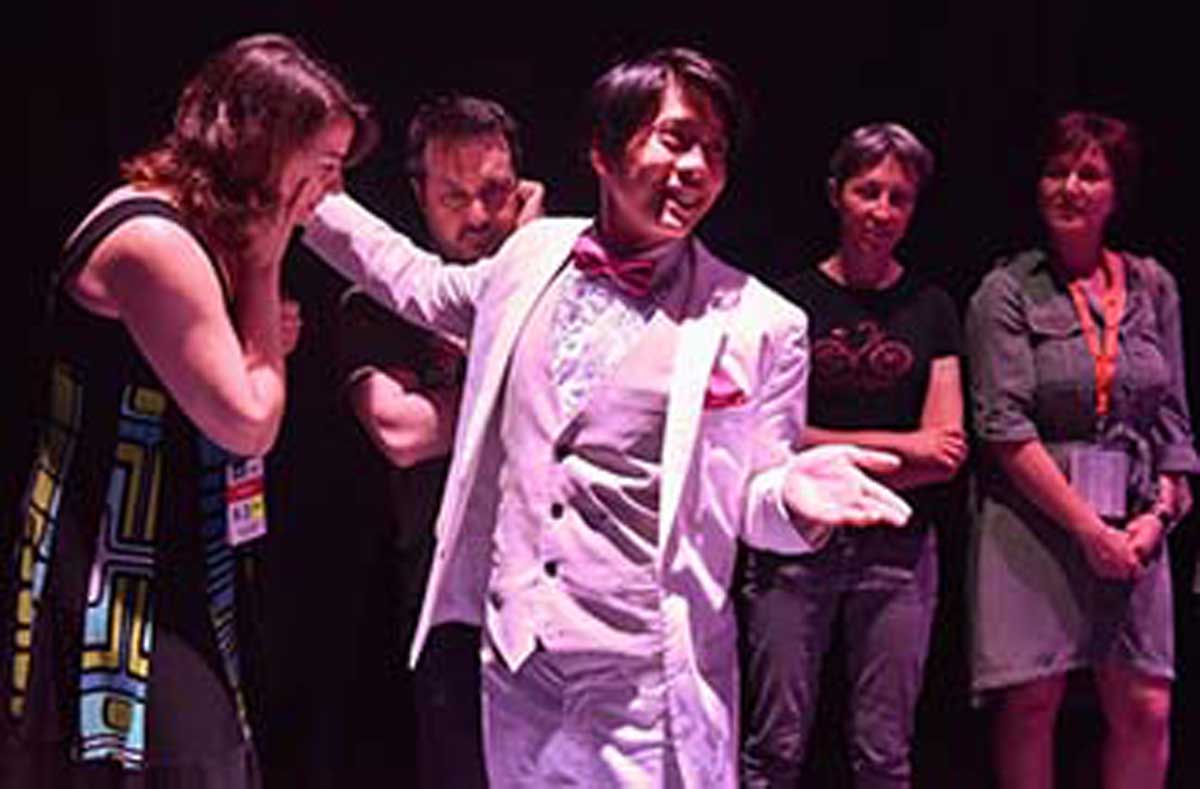WHAT WAS THAT? experiencing virtual reality as a performer
On a windy September afternoon, I took my third year drama students to a suburb of Gloucester, UK, to experience performing in virtual reality.
The production, Our Dancing Shadow, by Kaleider, was being staged as part of a local performance festival and it was an interesting spin on the regular arcade virtual reality (VR) experience. A stage was set up on a traffic island in a housing estate. There was lighting, atmospheric music, smoke and seven red circles marked out on the stage in rope. My students and I were each given a VR headset and a shiny gold jacket, directed to position ourselves in one of the circles and to move around as expressively as possible as we navigated the virtual world Figure 1. The VR experience was fairly simple; we were immersed in a starry galaxy and instructed to chase the brightest stars we could see with our hand-controller which operated like a magic wand in the virtual world. Without our being particularly conscious of it, our balletic movements created a kind of rough dance spectacle to be enjoyed by the audience which gathered around the stage - so much so that when our 10 minute slot was up and we removed our headsets we were greeted with a hearty round of applause, despite our not really being aware of the movements of our bodies. Here are some of the comments made by my group:
‘So what exactly were we doing then?’ ‘It didn’t feel like performing, but it kind of was.’ ‘I thought I was playing, or kind of travelling in space.’ ‘I was just trying to follow the rules, I didn’t want to mess up.’ ‘I felt completely alone.’ ‘I’m not sure what I was doing or where I was.’
Looking at the company’s website these are typical of the reactions to the piece (Kaleider, 2018) and the points raised about the confusing nature of the experience are entirely moot. With the rapid growth in the popularity of immersive experiences, questions about the aesthetic strategies of production and reception are becoming more common because the experiences generated simply do not fit the categories we are accustomed to. What it means to be an audience, an artist, a user, a player, is shifting quickly as new formulations of artistic experience outstep both the language and structures that have previously contained them.
This article proposes that models for reasoning about new aesthetic relationships may be found outside contemporary Western cultural styles and within the ancient dynamics governing indigenous storytelling traditions - specifically the traditions of the Australian songlines. It considers how innovations in digital technology can lead us to reconsider these historic narrative practices as a way of understanding forms of artistic exchange within virtual and intermedial spaces.
THEATRE AND AUDIENCE – a background
Theatre has been managing slippery relationship with its audience for aeons. The forms of drama, as well as its lineage, speak above all else of a centuries-long tussle with the audience/performer dynamic, negotiated through ever changing formulations of auditoria. As the images in Figure 2 demonstrate, the ongoing explorations of this fundamental connexion have been written into the design of theatres throughout history, each demonstrating different approaches to either allowing the audience into the performance space, or alternatively, keeping it at arm’s length. This ongoing negotiation of the relationship between the performance and the audience has always served to keep the artform vibrant, alive and bristling with the knowledge that the assumed hierarchy - the performer produces art for the audience to consume - is a precarious thing.
And yet for all the potential instability of the performance/audience dynamic, the behaviour of the performance spectator is, for the most part, predictable. Mainstream Western theatre tends to actively suppress audience agency. As Hans-Thies Lehmann, author of Postdramatic Theatre, has suggested, since the Enlightenment, and particularly with the development of Naturalism, the idea of the audience being a group of individuals with the capacity for creative involvement has been stultified by the structure of theatre in which: ‘the subjectivity of persons is transcended by the form’ (2006: 94). Like the spectator characterised in Jacques Ranciere’s The Emancipated Spectator who: ‘remains immobile in her seat, passive […] separated from both the capacity to know and the power to act’ (2011: 2), the contemporary theatre audience is generally in the dark, keeping silent and still in their numbered seat, as the art flows over the fourth wall for their consumption.
This is the background against which immersive and interactive arts have had their rapid growth in popularity, particularly since the turn of the 21st century. In the fine and digital arts, as well as across the performing arts - from experimental participatory theatre to commercial immersive events - the Experience Economy (Pine 1999) has coaxed and sometimes jolted audiences out of a general acceptance of their traditional passive role of reception. The possibilities posed by increased audience agency within a changing culture have been welcomed with enthusiasm, particularly by commentators and academics, who have interpreted it as promising new levels of emancipatory creativity for the audience. In a short programme about the future of storytelling, Felix Barratt, the director the pioneering immersive company, Punchdrunk, remarked:
The traditional theatre going experience is one that is utterly formulaic. What we are trying to do with Punchdrunk is the absolute opposite, we are trying to activate, to switch on your head, so you are physically involved and have actual, real, tactile, contact with another living entity […] you have shifted from being a faceless anonymous audience member to having a role to play in the story. The audience are our complete starting point. The future of storytelling is placing the audience at the heart of the experience (Barrett 2013).
However, the problems of positioning audience agency in opposition to passivity are complex. While it may be formulaic, the traditional live performance has a particular ‘aura’ (Benjamin 2008[1936]: 6), and this charged auratic atmosphere can prompt each audience member to cognitively interact with the work, without moving from their seat. Umberto Eco’s concept of the ‘open work’ (1989: 18), which proposes that artworks emphatically open themselves to many interpretations beyond the imagination of the author, and Roland Barthes notion of the ‘death of the author’ and ‘birth of the reader’ (1993[1967]), prepared the way for validating the idea of an active audience involvement of a cognitive nature, brought about through an individuated process of viewing. A growth of interest in phenomenology and in the cognitive sciences have, furthermore, provided mechanisms to reason about the individual spectator’s creative responses to artwork and these have challenged assumptions about passive consumption.
Digital Differences/Language Limitations
At this date I was a lover of the theatre: a Platonic lover, of necessity, since my parents had not yet allowed me to enter one, and so incorrect was the picture I drew for myself of the pleasures to be enjoyed there that I almost believed that each of the spectators looked, as into a stereoscope, upon a stage and scenery which existed for himself alone, though closely resembling the thousand other spectacles presented to the rest of the audience individually (Proust [1927] 2003: 104).
Innovations in technology have the power to change the way we imagine aesthetic exchange. Just as the young Marcel Proust’s fantasies about theatre were informed by the development of stereoscopic photography, so too have developments in interactive immersive technology prompted innovative speculation about the intricacies of the audience/performance dynamic. When art and technology mingle together in a new way it tends to provoke a shift in the relationship between the artist and their audience as the phenomenological condition of the spectator, and their sense experience of the artwork, is emphasised through the employment of technology. Oliver Grau has explored how innovations in art, from developments in perspective to the emergence of digital interactivity, have led to increasingly immersive experiences: ‘Immersion arises when artwork and technologically advanced apparatus, message and medium, are perceived to merge inseparably’ ( Grau 2003: 339). He goes on to observe how, with immersive art, it is the perception of the onlooker and the duration of their experience that becomes paramount rather than the work itself as a discrete piece: ‘ in this moment of calculated “totalization” the art work is extinguished as an autonomously perceived aesthetic object for a limited period of time’ (2003: 340).
The significance of the sensorial experience of the audience has similarly been a central concern in the development of intermedial performance. While not necessarily immersive, intermedial performance often employs the tropes of immersive art, forming a kind of bridge between physically immersive work and traditional theatre. It does this partly by using digital imagery alongside live performers in a way that prompts the spectator out of their passivity and forces a cognitive interaction by requiring them to frequently and rapidly shift focus between multiple live and digital performance elements.
The result is that each audience member will experience a different performance because of how they actively focus on different elements to one another and so travel through the work on a personal journey. The American Wooster Group has, throughout its 46-year history, employed this technique; critic Bill Brantly’s review of the company’s 2005 production, House/Lights, conveys the audience experience:
Your senses no longer know what they are supposed to fasten on. Everything has become so fragmented that no single sight or sound is fixed. Human voices and mechanical hiccups are given equal weight. And people are never simply themselves. Why, at a given moment you can pick from five or six versions of that shiny eyed seductress who rules the stage… Should you watch her on all those television monitors, where her face keeps dividing, multiplying freezing and melting, and changing colour. Or should you just do what you usually do in the theatre and focus on - you should pardon the expression – the real thing. That is not as obvious a choice as you may think, since the flesh and blood woman (her name is Kate Valk and she may well be the most accomplished actress in NY) seems a little less complete, less fulfilled, than her video cast self (Brantley 2005).
Brantley articulates the effect of attentional fragmentation produced by being presented with material which is ultimately ‘unsorted’ (Kaye 1994: 126). Confronted with narratives that announce multiple possibilities for engagement, the spectator is prompted into an active and creative response. This kind of heightened cognitive activity from a sedentary audience seems considerably more animated than the quality of engagement from an audience at a more formally Naturalistic production - although ostensibly both audiences would appear to be similarly occupied.
Conversely, the experience of an immersive performance may not be automatically empowering when possibilities for interaction are entirely anticipated by the artwork, leaving little room for meaningful audience input. Furthermore, when immersed within the work, the audience is no longer able to remain external to it, and so what they lose, which a traditional audience always has, is a critical perspective. Through becoming implicated in the production, external objectivity and judgement becomes compromised and the audience is no longer in a position to interrogate the work’s operational principles. Rancière’s criticism of ‘hyper-theatre’, his term for immersive work, draws attention to the way in which the audience is manipulated into imagining they have active agency while in fact any emancipation is illusionary, compromised as it is by a tight and controlling immersive structure from which the audience cannot separate themselves sufficiently to comment on, or even perceive it (2011: 6).
This complexity around immersive arts calls for wider debates about issues of aesthetic production and reception that lie at the foundation of emerging genres. Immersivity questions traditional assumptions that the artist produces the art and the audience consumes it: production/reception is the under-discussed binary opposition that shapes the way artists and audiences position themselves in relation to the world. Challenging these apparently neutral and embedded concepts means taking on the basic building blocks of aesthetic exchange, including their economies, social dynamics, structures and language. For, as the students discovered at their VR performance – it is difficult to conceptualise and discuss the experience of art when it falls outside the discourse of production/reception: these new kinds of immersive practices lack a consistent language or reference points to explain them.
As Rachel Fensham describes, it becomes impossible for many current systems of theorising to reason about the performer/spectator relationship in a way that captures what she refers to as the ‘hidden messiness’ of the spectatorial practice’ (2009: 13). She argues that while recent immersive performance gives agency to the spectator, the language and the structures around it are limited and inappropriate. She points out how the language of spectatorship prioritizes the gaze focusing on one sense that the spectator may use as if it is the only one. Indeed, the darkened auditoria of theatres encourages us to prioritise only our seeing and hearing senses, and to de-prioritise anything to do with the senses concerning action or body, feeling or speech. The emphasis in performance theory has always been on the senses of listening and viewing, as the etymologies of the terms ‘audience’ and ‘spectator’ suggest. It has consequently overlooked ‘the other parts of body whose presence is so important to the theatrical relation (ibid). She adds: ‘In so doing it has done a disservice to the collective sensibility of the viewing experience for theatre audiences’ (ibid).
Audience theory, particularly since the work of Susan Bennett (1997) and Herbert Blau (1990), has increasingly dwelt on the complexity of the role of the onlooker in the production of the art experience. Consequently, new ways of considering the agency awarded the audience as they experience performance, flows freely through contemporary scholarship, inviting an engagement with concepts like: ‘ergodic engagement’ (Aarseth 1997), ‘radical intimacy‘ (Doyle 2006) and ‘affective resonance’ (Pais 2016). But this terminology is a long way from becoming consistent or mainstream, and seems to lag behind many of the actual new experiences being offered to audiences, particularly by live performance which engages with digital and virtual technology, a shift that has become prolific since the Covid pandemic forced so much performance work online. Since the pandemic particularly, the sort of intermedial performance that awards meaningful agency to its audience, either through digital interactivity, or by the affordances of immersive environments, has provoked debates about how to reason and theorise about this kind of work in which the dynamic between artist and audience is always foregrounded and always unstable, for example at the Digital Research in Humanities and Arts conference, Berlin August 2021 and the Post-Covid Arts Conference, Hannover, July 2021. Less frequently engaged with are the more seismic shifts in the definitions of artist and audience that are being explored through new work, or the need to interrogate the fundamental quality of artistic exchange. However, outside the mainstream culture and the Western traditions of aesthetic dynamics, are models of artistic practice that do not operate within the purview of production/reception and that suggest that there are other ways of engaging with narrative performative practices that predate and exceed the parameters of dominant traditions.
INSCRIBED IN THE LAND – a view of indigenous artistic practice
Across the Australian continent stories of the indigenous culture are inscribed in the land. The entire landmass may be seen as a network of stories that are variously known as songlines or dreaming tracks. Songlines may be shared by clans living across vast geographical areas with individual members of each clan having custody of the part of it that relates to their homeland. The complete songline can only be realised through each custodian relating their section of the narrative by travelling the segment of land that it relates to. The stories themselves may tell of totemic animals or plants, often referred to as ancestral figures from the ‘Dreaming’ or ‘Dreamtime’ (Bell 1998). As well as recording the activities of the ancestors, the songlines function as mapping devices, recording locations of waterholes, mountains, hunting grounds - all that is needed to survive in the land. Each clan’s songlines can be activated when the people responsible for them cross the land singing its story to life through their voice and movement. As Marcia Langton, anthropologist, explains: ‘the person relating the story will then meet up with the next clan who will know the next part, and so the journey of the story will cross the continent’ (2008).
Fundamentally the construction of songlines subverts the notion of a binary opposition between the producer (artist) and receiver (audience). Instead of these roles being separated and in opposition, they are merged in the role of the person who has custody of the story as both producer and receiver and responsibility for re-inscribing it in its landscape through their actions. Songlines are said to be meshed together like a giant fishing net laid out over the land Figure 4. None of them are complete on their own, but dependent on others. While many have been lost, as a direct result of the destructive processes of colonialization, there are, according to Langton( 2008), enough songlines still in operation, to evidence this structure of co-dependent performative narratives whose existence functions as a multilinear model of connectedness. Songlines continue to be able to demonstrate how performative stories can operate, in a manner outwith the Western conventions of hierarchical production and reception, and their operation is of untapped relevance to contemporary concerns about the shortcomings of traditional Western models of aesthetic dynamics for emerging immersive practices. Songlines are inherently immersive and interactive in the same way as genres of contemporary immersive performance. Both forms involve environments that have stories built into them and depend on a user’s interaction with the space to produce those stories. Similarly, in both indigenous stories and immersive performances, the user (who is neither spectator nor producer) is in a position of creatively generating an experience. With the songline, the role of the artist is more obscure and the very notion of aesthetic production and reception is compromised under the force of a praxis which melds space, time, action and story.
A Problem of Translation
It is important to acknowledge the difficulties in engaging with First Nations’ cultural practices from a Western standpoint. These difficulties, as Richard Martin (2013) has explained, have been present throughout Australian colonial history up to the present day. Attempts to understand and analyse the nature of songlines have been often characterised by a lack of recognition of the sacred and singular nature of the practices, and by unsuccessful efforts to translate the songs into other forms, particularly written forms, in order to enable them to reach a wider Western audience. However, as John Bradley illustrates, it is the songlines’ very resistance to being resolved into a Western form of aesthetic production and reception that denotes their particularity, and I would add, their relevance to a debate concerning contemporary challenges to the rules and customs of art that are posed by new forms of immersive practice.
Illustrative of the issues around the ‘translation’ of songlines is Bradley’s commentary on the incommensurable nature of Western cultural mores and aboriginal traditions of storytelling, in which he refers to the Yanyuwa clan of the Northern Territory and their culture: ‘Yanyuwa understandings […] have nothing to do with Western systems of categories; rather their knowing was and is about the relatedness of humans, non-humans and objects and the potential power to move between them’ (2010: 134). He goes on to describe an occasion when an elder of the Yanyuwa clan was singing and how: ‘On that day at Kalkaji [a site on Yanyuwa country] Jerry [a senior Yanyuwa man] was concerned about regenerating his relationship to that country, and the authority he derived from the matrix of interconnectedness that was Yanyuwa law’(ibid).
While Bradley et al reject any Western appropriation of Aboriginal forms, positing the radical alterity of Indigenous understandings to Western ways of thinking, other anthropologists, scholars and artists, particularly those with an interest in emerging aesthetic forms, have identified a resonance between the networked structure and implicit interactivity of songlines and the operational assemblages of contemporary digital and immersive technology. This synergy between Aboriginal story systems and contemporary immersive digital modes was recognised as early as the 1980s by Barbara Glowczewski. She noticed that advances in technology, facilitated by the development of hypertext mark-up language(html), were altering and extending narrative practices, and new interactive and non-linear reticular models of storytelling bore striking similarities to ancient Indigenous structures.
Non-linear or reticular thinking stresses the fact that there is no centrality to the whole, but a multipolar view from each recomposed network within each singularity — for example, a person, a place, a Dreaming — allowing the emergence of meanings and performances, encounters, creations as new original autonomous flows (2005: 24).
Similarly James Barrett (2009) observed that digital media and indigenous narratives: ‘each had shares in basic concepts of co-creativity, mediation and spatiality’ (2009: 3) and argued that narrative structures, that are characterised by types of immersion and interactivity, resonate more closely with structures that exist in ancient indigenous storytelling traditions like those of Australia and ‘do not function according to the uses developed under material regimes of western story telling particularly since the Enlightenment’ (ibid). Indigenous art curator Candice Hopkins also recognises the wider significance of a narrative being formed as a mutating network, describing Indigenous stories as continually: ‘changing, individualized and communal, original and replicated, authored and authorless’ (2006: 341). While these commentaries focus on digital narrative work, I would suggest they would also apply more widely to immersive performance work. Hopkins’ characterisation particularly is relevant to performance – where it becomes apt because it describes the increasingly common situation in which the ‘audience’ becomes involved in performative actions that operate as a generative process and instigate the aesthetic event.
RECOLLECTION : Foreign Radical – by Theatre Conspiracy 2015–20
The piece opens in the first of four connected rooms. It is starkly lit and there is a naked man tied to a tabletop. It soon becomes apparent that the setting is an airport border control and we, the spectators, are to be quizzed and cajoled into deciding the fate of this unnamed interrogation victim. He has been apprehended and his status is unclear. There are decisions to be made, things to be found out. Leading the proceedings is Milton Lim as the ‘host’ (Figure 5) who relentlessly fires questions at us in order to decide who among us can be trusted: ‘have you ever taken part in a political protest?’, ‘how often do you change your online password?’, ‘have you watched online porn this week?’. According to our answers we are divided into different groups, taken to different spaces and given new tasks. Videos of Arabic text, surveillance camera footage and unidentified Middle Eastern landscapes are projected all around. At one point some of us are instructed to search a suitcase and report back on suspect items found. Knowing we are under close video surveillance by spectators in another space, we tentatively rummage. Nails, drugs, and some dodgy looking items in a bag that might be part of a bomb, are found and, on the basis of these, we must decide the fate of the case’s owner. Finally, the man from the first room reappears, now clothed. He takes charge of proceedings and turns the interrogation onto particular spectators with apparently benign questions about their experience of travelling across borders. But the videos tell another story, and we realise that in this context nothing is what it seems.
The performance cleverly uses and manipulates spectator choice. There is no straightforward fictional world presented for our consumption in Foreign Radical, all that exists is a network of possibilities and our individual lived experience of it. Furthermore, our relationship to this world is multifaceted: the diversity of narrative techniques used in the performance provokes continually changing dynamics between the spectators and the event. The omnipresent media in the performance prompts a consideration of the slippage between the world of the performance, the mediatized world of international politics and our actual worlds. Essentially, the production enacted worlds of our creating and consequently we became implicated in its processes and culpable in its outcomes. We were creators of the stories we experienced – and were also created by it, in that our decisions, made through the piece, marked and inscribed our process. The significance of the space and of our interaction with it is paramount in Foreign Radical. The dichotomy of performing and spectating is broken, because just as the spectators become performers, so to the ‘official’ performers become spectators – watching, judging and making decisions about us spectators, based on our actions. Foreign Radical concerns a contemporary political crisis, but it also foregrounds a crisis in the practice of spectating of a kind which is played out regularly in interactive work when spectators are caught up in the liminal zone between traditional audience reception and agency.
Categories and Custody
Steve Dixon’s categories of interactivity have become an important reference point in considering how performance interaction might be classified. They suggest that the manner of a spectator’s interaction falls into one or more of the following types:
Navigation
Participation
Conversation
-
Collaboration
Each of these categories denotes a different level of agency - from the focussed choice suggested by ‘navigation’ to the genuine and meaningful dialogue between the user and the artwork that characterises ‘conversation’. Dixon stresses that the suggestion of a hierarchy of spectator creativity in these categories should not be seen as a comment on the quality or impact of artworks. And he goes on to discuss the elusiveness of the concept of creative freedom, citing David Rokeby’s comment that: ‘An interactive artist can give interactors the impression that they have much more freedom than they actually do’ (2015: 563). Dixon’s recognition that creative freedom may simply be a symbolic trope, and his categorisations slippery and not an exact science, indicates that his classifications function best as a gateway to a necessarily more complex and nuanced consideration of engagement within the immersive environment. And it is in this more charged and complex consideration of the dynamics of aesthetic production that models provided by Indigenous narrative structures can play a part. Perhaps one of the more obvious aspects that the consideration of songlines as a model gives to this area of enquiry is the shift in dynamic when a ‘spectator’ becomes truly responsible for a part of the narrative as a ‘custodian’ - to borrow the frequently employed term from Indigenous Australian scholarship. Three years after seeing a performance of Foreign Radical I am still marked by the decisions I made within that piece which I have owned, feel responsible for, and have carried forward. These stories are now part of me, yet I still cannot define my actions within that performance as either production or reception, or know if I was performing or spectating, or position my activity within one Dixon’s categories – to do so would be as reductive as translating a songline into a story book. Like the students participating in the Kaleider VR event, I find that my experience of Foreign Radical cannot be contained or described by the language offered to me in the constrained purview of theatre scholarship. But when I step outside that, and into the world of the Australian First Nations’ storytelling traditions, I can start to see a way of occupying a piece of art, and existing within and beyond it, and this lends meaning and context to the experience of immersivity way beyond the simple novelty of joining in.
Ancient Routes/Future Roots
We are at a time when, in considering audience engagement, there is a need to engage with the wider possibilities of production and reception, and with new theories that do not prioritise an intransient binary between audience and performance. The songlines tradition suggests that within an immersive and interactive event, the notion of the spectator or audience is less useful than the idea of custodian, which denotes, among other things, a responsibility for holding and carrying forward an experience. Songlines also indicate ways in which the history and habits of a person can be modelled to have a structural importance in the event.
The inadequacy of the language around new immersive and interactive practices severely limits debate and leads to erroneous assumptions that interactivity automatically suggests a level of control that conventional audiences lack. There exists a clumsiness around the increasingly ubiquitous immersive terminology that holds back cultural debate. In finding a way to articulate complex ideas about aesthetic exchange, the songline tradition points to methods and concepts that can be helpful and enlightening and, as has been discussed through the work of Barrett and Glowczewski, have a particular resonance with emerging digital narrative structures. Despite their appearance, new types of storytelling have ancient roots - and we need to look back as well as forward as we debate the future of immersive performance.
Competing Interests
The author has no competing interests to declare.
Author Information
Dr Elizabeth Swift is a UK writer and director of intermedial performance. She lectures in Drama at Gloucestershire University and studied at Lancaster and Exeter Universities. Publications include articles in The International Journal of Performance Arts and Digital Media and a chapter in the Palgrave Macmillan publication, Framing Immersive Theatre and Performance. In 2019 Liz was selected to represent the UK at the British Academy’s International forum on the Future of Storytelling in Australia. Performance projects include the digital opera, Two-Sided Boy, presented at Glyndebourne’s ‘Opera, the Media of the Future’ and in London at the ‘Second Movement’ opera platform.
References
Aarseth, Espen 1997 Cybertext: Perspectives on Ergodic Literature. Baltimore and London: The John Hopkins University Press.
Barrett, Felix 2013 Burn the Seats: the Future of Storytelling. Available at https://www.youtube.com/watch?v=6ktpes0qMZ0 (Last Accessed 25/10/21).
Barrett, James 2009 Narratives of Creation and Space: Pilgrimage, Aboriginal and Digital. FORMAT (Poland), 55: 18–19. Available at https://www.researchgate.net/publication/284837500_Narratives_of_Creation_and_Space_Pilgrimage_Aboriginal_and_Digital (Last Accessed 25/10/21).
Barthes, Roland 1993[1967] The Death of the Author. Trans. Heath, S in Image, Music, Text. London: Fontana Press.
Bell, Diane 1998 Ngarrindjeri Wurruwarrin: a world this is, was and will be. Melbourne: Spiniex Press.
Benjamin, Walter 2008 [1936] The Work of Art in the Age of Mechanical Reproduction. Translated by J. A. Underwood. Penguin Great Ideas. Harlow, England: Penguin Books.
Bennett, Susan 1997 Theatre Audiences – A Theory of Production and Reception, second edition. New York and London: Routledge.
Blau, Herbert 1990 The Audience. Baltimore and London: The John Hopkins University Press.
Bradley, John 2010 Singing Saltwater Country: Journey to the Songlines of Carpentaria. Crows Nest, NSW: Allen & Unwin.
Brantley, Ben 2005 House/Lights review. New York Times: P:42, 28-02-2005.
Dixon, Steve 2015 Digital Performance: A History of new media in Theatre, Dance, Performance Art and Installation. Cambridge: MIT Press.
Doyle, Jennifer 2006 Critical Tears: Franko B’s “I Miss You”. In: Johnson, Dominic (ed.) Blinded by Love. Bologna: Damiani. Available at http://www.franko-b.com/Critical_Tears.html (Last Accessed 25/10/21).
Eco, Umberto, Annapaola Cancogni, and David Robey 1989 The Open Work. Cambridge, Mass: Harvard University Press.
Fensham, Rachel 2009 To watch theatre: essays on genre and corporeality. Bruxelles & New York: P.I.E. Peter Lang.
Glowczewski, Barbara. 2005 Lines and Criss-Crossings: Hyperlinks in Australian Indigenous Narratives. Media International Australia, 116(1): 24–35, (Last Accessed 25/10/21) DOI: http://doi.org/10.1177/1329878X0511600105
Grau, Oliver 2003 Virtual Art: From Illusion to Immersion. Cambridge: The MIT Press. DOI: http://doi.org/10.7551/mitpress/7104.001.0001
Hopkins, Candice 2006 Making Things Our Own: The Indigenous Aesthetic in Digital Storytelling. Leonard, 39(4): 341–344. (Last Accessed 25/10/21). DOI: http://doi.org/10.1162/leon.2006.39.4.341
Kaye, N 2007 Multi Media – Video, Installation, Performance. New York and Abingdon: Routledge.
Langton, Marcia 2008 First Australians/songlines on Screen/Njambi. Available at https://www.sbs.com.au/ondemand/video/1421213251927/songlines-on-screen-njambi (Last Accessed 25/10/21).
Lehmann, Hans-Thies 2006 Postdramatic theatre. London; New York: Routledge. DOI: http://doi.org/10.4324/9780203088104
Martin, Richard 2013 The Politics of the Voice: Ethnographic Fetishism and Australian Literary Studies. Journal of the Association for the Study of Australian Literature [Online], 13(2). Available at https://www.academia.edu/25566459/The_Politics_of_the_Voice_Ethnographic_fetishism_and_Australian_literary_studies (Last Accessed 25/10/21).
Pais, Ana 2016 Re-Affecting the Stage: Affective Resonance as the Function of the Audience. Basel, Switzerland: MDPI. DOI: http://doi.org/10.3390/h5030079
Pine, B. Joseph 1999 The Experience Economy : Work Is Theatre & Every Business a Stage. Boston: Harvard Business School Press.
Proust, Marcel 2003[1927] Scott-Moncrieff, Charles. (Trans). Swann’s Way1 (In search of lost time). New York: Heritage Press.
Rancière, Jacques 2011 The emancipated spectator. London: Verso.
